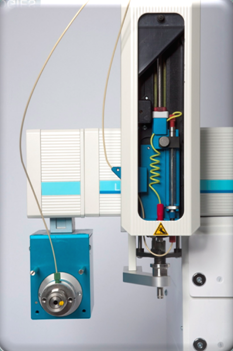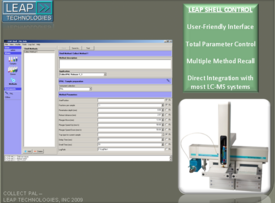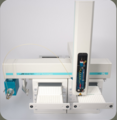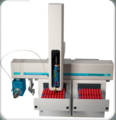Small Volume Fraction Collection
From LEAP
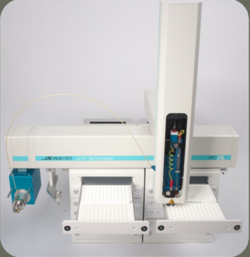
| Collect PAL |
| Application Type | |
| Purification | |
| Application ID | |
| Description | |
| Collect PAL |
Contents |
Overview
The Collect PAL as shown can hold up to 24-shallow well plates and collect into either 96-well or 384-well plates. It is shown with its waste drain and high pressure valve set up. With this valve it is able to use down to 0.005” id PEEK tubing.
Compact in size, the Collect PAL covers a bench area of only 28”x28” and has a height of only 24” to the top of its Z-arm.
Key Features –
- Zero Loss Collection – most fraction collectors either are a drop-type or a solenoid driven-type.
- Zero Drips, Zero Spills
- The drop type fraction collector simply flows the effluent through tubing to a movable arm and positions the tubing over a well or tube and stays in that position for a specified time until moving to the next collection site. The main concern with this type of fraction collection is the complete lack of control over volume in the fraction site and, more importantly, the placement of each and every drop in a tube. There should be concern that sample can be lost during the “in-between” of sites during a move.
- The solenoid drive fraction collector solves the drop between sites problem by quickly switching a solenoid valve off/on during the move between wells. Drip solved, but now valuable sample during that movement is sent to a waste stream. Sample is lost to the waste.
- Neither type of fraction collection option protects what is most important – the sample -- and provides a safe environment for the researcher.
LEAP employs an inverted syringe technology, design, and control that eliminates the drops between sites and also eliminates the lost sample to waste of both drip and solenoid type fraction collectors.
The inverted Syringe and control via LEAP SHELL software
- Ability to collect through septa, capmats, plate seals. No one else can do this with ZERO LOSS. – Beats Solenoid fraction collectors
- Collect a constant, precise, user-defined volume per well or tube
- Touch-off Fraction Collection with LEAP SHELL you can send the needle to a specified height and then retract; offering a touch-off fraction collection within a well.
- 3 sec/well fraction collection available in 384-well plates.
- Deep-well, shallow-well or 2-mL vial collection set up.
- 2 Stack Configuration – Up to 12 plates or trays
- Max number of fractions per injection – Remember that you can only collect within the same collection plane. The maximum number of plates per injection available for collection = 4
- 2-mL Vials – 4x54 = 216
- 96-Well Plate – 4x96 = 384
- 384-Well Plate – 4x384 = 1536
- You can also just collect into a pre-determined number of fraction sites per plate.
Software
- LEAP SHELL CONTROL
- User-Friendly Interface
- Total Parameter Control
- Multiple Method Recall
- Direct Integration with most LC-MS systems
- Living Sample List
- Priority Scheduling
- Import/Export Run Lists
- Multiple Methods Available per Run
Screenshots
Markets
DMPK
Drug Metabolism & PharmacoKinetics studies a range of stable isotopically-labeled products that can provide accurate and non-radioactive in vivo studies of both nutrition and metabolism. Compounds labeled with stable isotopes like Carbon-13, Nitrogen-15, Deuterium and others can be identified and measured using techniques such as MRI and MRS
ADMET
Adsorption ,Distribution, Metabolism, Excretion, and Toxicity – drug properties – are fundamental pharmacokinetic properties that determine the in vivo efficacy of a drug, together with its intrinsic biological activity on the target. Metabolomics (from Wikipedia – this section is a good read) is the "systematic study of the unique chemical fingerprints that specific cellular processes leave behind" - specifically, the study of their small-molecule metabolite profiles[1]. The metabolome represents the collection of all metabolites in a biological organism, which are the end products of its gene expression. Thus, while mRNA gene expression data and proteomic analyses do not tell the whole story of what might be happening in a cell, metabolic profiling can give an instantaneous snapshot of the physiology of that cell. One of the challenges of systems biology and functional genomics is to integrate proteomic, transcriptomic, and metabolomic information to give a more complete picture of living organisms
